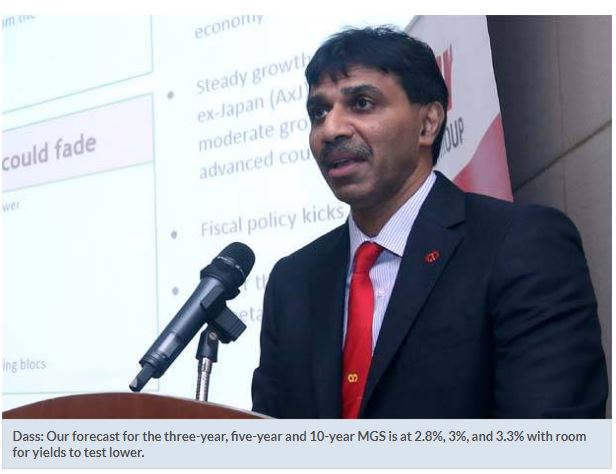Move to hold rates may attract foreign inflows into Malaysia
PETALING JAYA: The move to hold the key benchmark rate unchanged may attract foreign capital flows into Malaysian bonds but much will be dictated by external headwinds after the latest data showed lower foreign holdings of local bonds.
Economists and bond analysts concurred that global monetary easing would see capital flows into emerging markets, including Malaysia, as investors seek higher yields across regional markets. They agreed that the global environment and local developments in the market may impact foreign holdings of Malaysian bonds, particularly the Malaysian Government Securities (MGS).
In August, foreign holdings of local bonds eased slightly, breaking the upward trend in foreign ownership seen in the last two months (June and July).
The local bond market recorded a total net foreign outflow of RM0.9bil (July: +RM5.8 bil). Meanwhile, total foreign holdings of local bonds stood at RM188.2bil (July: RM188.3bil), representing 12.6% of total outstanding, according to Malaysian Rating Corp Bhd (MARC) in its latest Monthly Bond Market & Rating Snapshot.
Year-to-date (YTD), cumulative flows into local bonds for the first eight months remained positive at RM3.4bil (2018 YTD: -RM19.3 bil), better than the full-year figures reported for 2016,2017 and 2018. By instrument, cumulative foreign flows into MGS stood at RM7.6bil (2018YTD: -RM10.6bil while other instrument types continued to be in negative territory.
The local bond market registered heavy foreign outflows in April and May due to possible exclusion of Malaysia from the World Government Bond Index (WGBI) and US-China trade tensions.
The trend reversed in June and July due to monetary easing by global and regional central banks which drove investors to hunt for higher yields across regional markets, including Malaysia.
Bank Negara in its latest Monetary Policy Statement issued on Thursday maintained the overnight policy rate (OPR) at 3% in line with market consensus amid rate cuts by key central bank in Asia-Pacific.
AmBank Group chief economist Anthony Dass told StarBiz that the appetite for capital to flow into this region remains and should benefit Malaysia.
Global monetary easing is expected to continue given the dynamics of the global business and economic climate which is pointing towards the downside, he noted.
“It should result to capital outflow which is expected to benefit emerging market, including Malaysia, simply because the advance economies have been sitting in a low interest rate environment since 2008 global financial crisis. Further monetary easing is more likely to have moderate impact.
“Nonetheless, the potential flow will be impacted by global adverse noises. Exacerbating the situation is the inversion of the 2-year and 10-year US Treasury yield curve, which sent a strong signal that a recession could be on the horizon.
“It is increasingly of the view that the US Federal Reserve will be forced to embark on a series of rate cuts, besides issues like trade tension, financial and political tensions, ” Dass noted.
On the local scene, he said the focus would be on domestic challenges like the September 26 decision by FTSE Russell decision whether to exclude Malaysian bonds from its WGBI, the outcome of the Budget 2020 and potential key incoming macro data.
These issues coupled with the political scenario would influence the foreign flow of funds, he added.
Dass said the carry trade theme did not resume. Gains in the MGS market were mostly contributed by local institutional investors as foreign appetite for MGS had lost traction in August, he said. Foreign holdings of MGS dipped by RM1bil to RM153.7bil amid the re-escalation of US-China trade tensions, Dass pointed out.
“Our forecast for the three-year, five-year and 10-year MGS is at 2.8%, 3%, and 3.3% with room for yields to test lower, ” he said. Malaysia’s 10-year bond yields were up by 0.45% to 3.36% from its close of 3.34% as at press time.
Meanwhile, Maybank Kim Eng head of fixed income research Winson Phoon, who is taking a defensive stance on the Malaysian Government Securities (MGS), had last month in a report said it was assigning a 55% probability for Malaysia to stay in WGBI following Bank Negara’s initiatives to enhance onshore forex and bond market liquidity. Nontheless, he noted that the risk of exclusion from the index should not be underestimated.
OCBC Bank (M) Bhd head of global treasury Stantley Tan felt with the backdrop of the global hunt for yield, he dependency of the WGBI is less of an issue taking cognisance that countries like Thailand and Indonesia remain clearly on the radar of foreign investors despite not being in the index.
RAM Ratings head of research Kristina Fong in responding to queries from this publication recently said that the upcoming announcement by FTSE Russell could be one of three things – for Malaysia to be taken off or retained on the watchlist or for Malaysia’s weight to be gradually pared down in the WGBI.
“We expect the former two scenarios to be more likely given the increased liberalisation introduced and reinforced by the central bank pertaining to onshore hedging rules for foreign investors, ” she noted.
In April, FTSE Russell said it would review the government bonds’ participation in the WGBI due to market liquidity issues. It has placed Malaysia on its fixed-income watch list for six months until September.
Source: https://www.thestar.com.my/business/business-news/2019/09/16/move-to-hold-rates-may-attract-foreign-inflows-into-malaysia#yQTdPfitGiu1rpKD.99


 Thailand
Thailand




